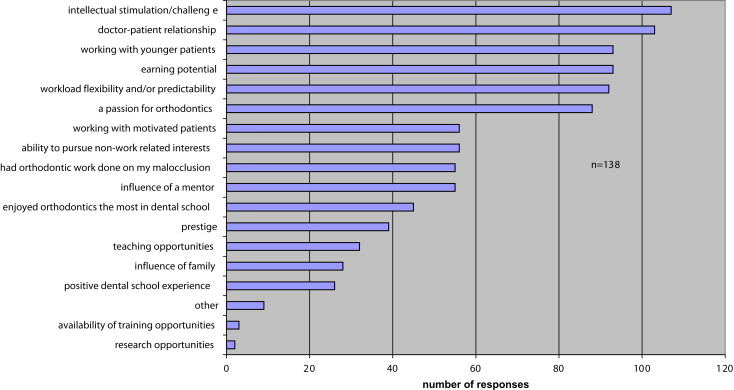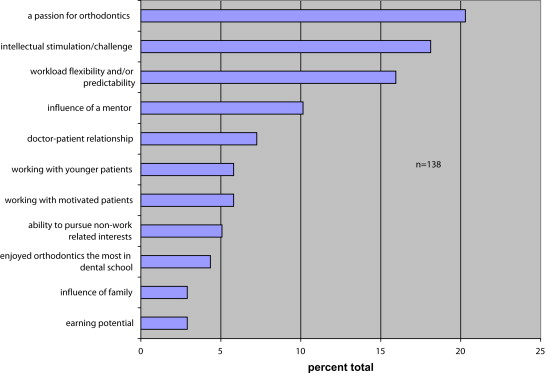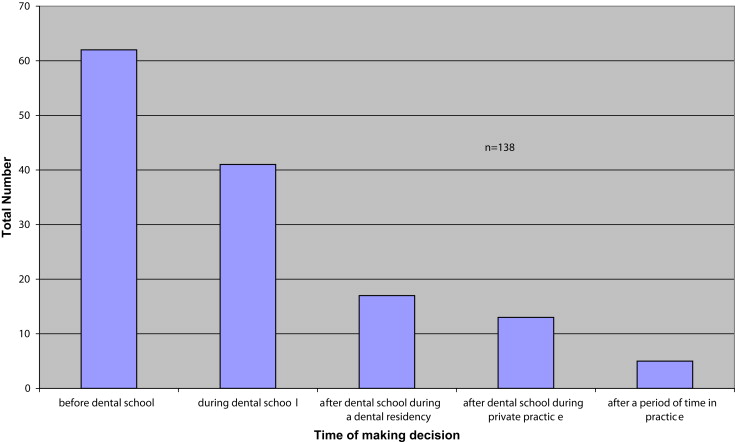Introduction
The purposes of this study were to investigate factors influencing career choice and identify future life plans of orthodontic residents in the United States.
Methods
Program chairs and directors of all 65 orthodontic residency programs in the United States were contacted by e-mail and telephone for permission to e-mail their residents and invite them to take part in on online survey. A total of 335 residents from 37 programs were invited to complete an anonymous 57-item questionnaire in May 2007. Data were categorized, and basic statistics including chi-square comparative analyses were performed.
Results
A total of 136 (40.60%) residents completed the survey. A “passion for orthodontics” emerged as the most important factor (20.29%) influencing the decision to pursue orthodontics as a career, followed by “intellectual stimulation or challenge” (18.12%). Most residents decided to become an orthodontist before they were in dental school (44.93%). Most residents (89.05%) plan to engage in private practice, and only 2 intend to pursue primarily an academic career. The average resident debt was $165,226 at the end of their program.
Conclusions
The decision to become an orthodontist is often made early in life, before dental school, and a passion for orthodontics is the motivational factor. Residents plan to enter private practice and not pursue a career in academia. The current shortage of academics and orthodontic researchers will not be resolved from the current pool of orthodontic residents. A possible solution to the academic crisis is to change the selection criteria in programs to accept orthodontic residents who develop a passion for orthodontics while in dental school or to recruit primary researchers and teachers to the specialty. Residents plan to practice in an urban setting. Rural and underserviced areas will probably continue to experience shortages of orthodontists in the future.
Orthodontics is the most popular of the postgraduate dental specialty programs in the United States, enrolling over 700 residents and graduating almost 300 each year. Currently, 65 orthodontic residency programs offer 2- or 3-year programs and a certificate or master of science degree on completion.
Two surveys of orthodontic residents in the United States, 1 in the United Kingdom, and 1 in Canada have been published. These studies found that residents chose orthodontics as a career because they expect future job satisfaction and intellectual stimulation. These studies established that most residents were interested in entering private practice after graduation, and few were considering an academic career involving teaching and research.
Determining what inspires residents to choose orthodontics as a specialty is potentially important information that orthodontic program directors can use as they try to recruit the brightest and best candidates into their programs. Program directors might be particularly interested in applicants who express a genuine interest in pursuing an academic career. Furthermore, the orthodontic specialty can gain an insight into the reasons for its popularity among dental graduates, and this might assist in recruitment strategies, particularly to underserved and rural areas, and academia.
The crisis in recruitment and retention of orthodontic educators has been well documented. However, the orthodontic community must provide supporting evidence that there will continue to be a shortage of persons interested in pursuing academic careers. This evidence will underscore the need for strategies directed toward a solution.
This study identified the reasons that orthodontic residents in the United States have chosen orthodontics as a career, their future aspirations, and their career plans after graduation.
Material and methods
The study received approval from the Research Ethics Board of the University of Manitoba. An e-mail was sent by the primary author (J.N.) to program chairs and directors (in some programs, this was the same person) of all 65 graduate orthodontic programs in the United States identified in the American Dental Association’s listing of accredited orthodontic programs. The questionnaire was attached to the email, and a request was made for permission to contact their residents by e-mail and invite them to participate anonymously in the study. Programs that did not respond to the e-mail request were contacted 3 more times by telephone; if they failed to respond, they were excluded from the study. An online program was used to send an e-mail with a personalized online link to 335 residents from 37 orthodontic programs. This link prevented any respondent from attempting to complete the survey more than once. The residents were invited to complete the 57-item survey containing multiple choice and 1-line answers in May 2007. As an incentive to complete the survey, they were informed that those who completed the survey would be entered into a random drawing to win a new orthodontic curing light. To ensure privacy and anonymity, no personal information was collected, and this was clearly emphasized to all residents with each e-mail communication. The participants were assured that the results of this study would be reported only as group data and could not be traced. The survey was divided into the following segments: demographics, reasons for choosing orthodontics, evaluation of their orthodontic program, and future directions. Data from the survey were then compiled into an Excel spreadsheet (Microsoft, Redmond, Wash) and categorized by demographic variables. Basic statistics and comparative analyses with the chi-squared analysis were undertaken by sex, age, and year of program.
Results
A total of 18 program chairs or directors responded to the e-mail request. After 3 additional phone calls to the program department, the e-mail addresses of residents from 37 programs were obtained. In some cases, program chairpersons forwarded the e-mail to all their residents and asked them to contact the author if they were interested in participating. Therefore, in some cases, 1 resident from a program was invited to participate. A total of 335 resident e-mail addresses were obtained. From these residents, 138 started the survey, and 136 completed it, resulting in a response rate of 40.60%. The average time to complete the survey was 12 minutes.
The sexes, ages, and years of study of the residents are given in Table I . There were 89 men and 49 women; most were between 25 and 34 years of age.
| Respondents | Number (%) |
|---|---|
| Age (y) | |
| <25 | 1 (0.72) |
| 25-29 | 71 (51.45) |
| 30-34 | 54 (39.13) |
| 35-39 | 8 (5.80) |
| >40 | 4 (2.90) |
| Sex | |
| Male | 89 (64.49) |
| Female | 49 (35.51) |
| Year in program | |
| 1 | 31 (22.63) |
| 2 | 67 (48.91) |
| 3 | 34 (24.82) |
Most residents (64.23%) entered their graduate residency program directly from dental school, and only 9 (4.95%) had a previous graduate degree.
Chi-square analyses showed no significant differences between age categories or between male and female residents ( P >0.05) for any results.
Factors influencing career choice
Respondents received a list of factors influencing their desire to pursue graduate orthodontics and were encouraged to select all factors that influenced their decision. Intellectual stimulation or challenge was the most common reason for these respondents to choose orthodontics as a career. Doctor-patient relationship, passion for orthodontics, earning potential, and working with motivated patients were other important factors they identified ( Fig 1 ). The residents were then asked to identify the single most important factor for choosing orthodontics. The results were a passion for orthodontics (20.29%), intellectual stimulation (18.12%), and workload flexibility and predictability (15.94%) ( Fig 2 ).


When asked when they made the decision to pursue graduate orthodontics as a career, most respondents (44.93%) said that they had decided before they were in dental school; 29.71% decided during dental school, and 12.31% decided after dental school during dental residency ( Fig 3 ).

Debt and future income
The average debt of orthodontic residents at graduation was $165,226 (n = 127) with a range of $0 to $500,000. When asked about projected income 1, 5, and 10 years after graduation, the results were as follows: 1 year after graduation, residents expected on average to earn $137,570 (n = 116) with a range of $60,000 to $250,000; 5 years after graduation, $306,336 (n = 116), with a range of $75,000 to $1,000,000; 10 years after graduation, $645,307 (n = 116), with a range of $200,000 to $5,000,000.
Future plans
Residents were asked about their practice plans after graduation. They were allowed to indicate all answers that applied. The most popular choice was to practice orthodontics as an associate (32.35%, n = 55), followed by buying into an existing practice (31.18%, n = 53) and starting their own orthodontic practice (21.76%, n = 37). Only 1.76% (n = 3) intended to pursue a full-time research and teaching career, and 1.76% (n = 3) intended to pursue graduate training in the form of an MSc or a PhD degree or work in research ( Table II ). Furthermore, when asked about type of practice setting, 89.05% (n = 122) said private practice, 1.46% (n = 2) said primarily a community setting, 1.46% (n = 2) said primarily an academic setting (teaching hospital or research institute), 6.57% (n = 9) said a combination of community and academic setting, and 1.46% (n = 2) were undecided.
| Plan | Percentage |
|---|---|
| Practice orthodontics as an associate | 32.35 |
| Practice orthodontics by buying into an existing practice | 31.18 |
| Practice orthodontics by starting a new practice from scratch | 21.76 |
| Military | 2.35 |
| Pursue a full-time research and teaching career | 1.76 |
| Pursue a graduate degree (MSc, PhD) or work in research | 1.76 |
| Apply for fellowship training | 1.18 |
| Undecided | 7.65 |
Most residents plan to practice in an urban or suburban setting (75.91%). Only 13.14% plan to practice in a rural setting and 2.92% in an inner city.
A total of 42.34% indicated that they wanted a solo practice, 30.66% preferred a group practice, and 26.28% were undecided.
Most residents (92.75%) intended to practice full time, defined as more than 3 days per week. Once in practice, 41.61% of the respondents indicated no time commitment devoted to clinical or didactic research, but 21.17% said they would like to spend 25% of their time on research.
Results
A total of 18 program chairs or directors responded to the e-mail request. After 3 additional phone calls to the program department, the e-mail addresses of residents from 37 programs were obtained. In some cases, program chairpersons forwarded the e-mail to all their residents and asked them to contact the author if they were interested in participating. Therefore, in some cases, 1 resident from a program was invited to participate. A total of 335 resident e-mail addresses were obtained. From these residents, 138 started the survey, and 136 completed it, resulting in a response rate of 40.60%. The average time to complete the survey was 12 minutes.
The sexes, ages, and years of study of the residents are given in Table I . There were 89 men and 49 women; most were between 25 and 34 years of age.
| Respondents | Number (%) |
|---|---|
| Age (y) | |
| <25 | 1 (0.72) |
| 25-29 | 71 (51.45) |
| 30-34 | 54 (39.13) |
| 35-39 | 8 (5.80) |
| >40 | 4 (2.90) |
| Sex | |
| Male | 89 (64.49) |
| Female | 49 (35.51) |
| Year in program | |
| 1 | 31 (22.63) |
| 2 | 67 (48.91) |
| 3 | 34 (24.82) |
Most residents (64.23%) entered their graduate residency program directly from dental school, and only 9 (4.95%) had a previous graduate degree.
Chi-square analyses showed no significant differences between age categories or between male and female residents ( P >0.05) for any results.
Factors influencing career choice
Respondents received a list of factors influencing their desire to pursue graduate orthodontics and were encouraged to select all factors that influenced their decision. Intellectual stimulation or challenge was the most common reason for these respondents to choose orthodontics as a career. Doctor-patient relationship, passion for orthodontics, earning potential, and working with motivated patients were other important factors they identified ( Fig 1 ). The residents were then asked to identify the single most important factor for choosing orthodontics. The results were a passion for orthodontics (20.29%), intellectual stimulation (18.12%), and workload flexibility and predictability (15.94%) ( Fig 2 ).




